I Tried Switching From Tampons And Pads To A Menstrual Cup To Save Money And Be More Sustainable; Here’s My Review
Hi, I'm Fabiana — a 28-year-old woman who is always trying to figure out what's best for my health — especially when it comes to things like birth control, period pain, and so on.

Last year I went off birth control — and wrote about it — and overall I'm (still) enjoying my experience being off it except for the return of painful period cramps and a heavier flow.
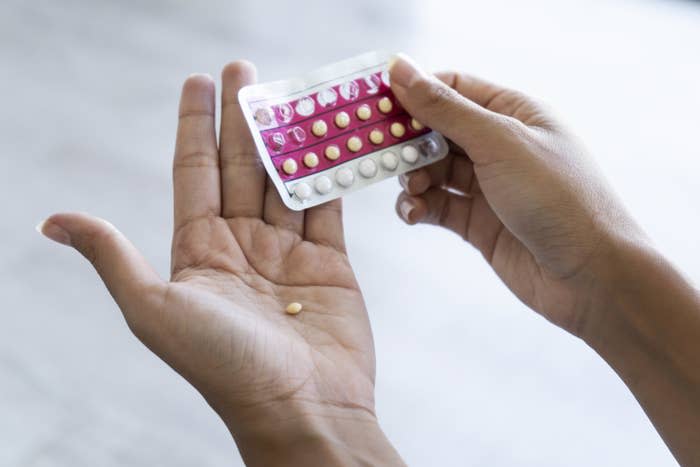
Speaking of a heavy flow — when I first got my period at around age 12 or 13, I solely used pads. Then as I got older and needed something not as bulky in my underwear when I danced or exercised, I turned to tampons.
Now when it comes to that time of the month, I always ensure my bathroom is stocked with pads and tampons. TBH, I never thought much about how limited my options were with period products until recently. It's pretty wild that the options for those who get their period are only pads, tampons, menstrual discs, or menstrual cups. (FYI: Cups and discs are two different products!)

Menstrual cups have technically been around since the late 1980s — the first menstrual cup in the US was manufactured in 1987 — but it wasn't until recently that I've been hearing more about people using and loving them. (Thanks to TikTok!) Although I was always intrigued by how menstrual cups worked, the word "cup" was honestly enough to intimidate me to never try them — until now.
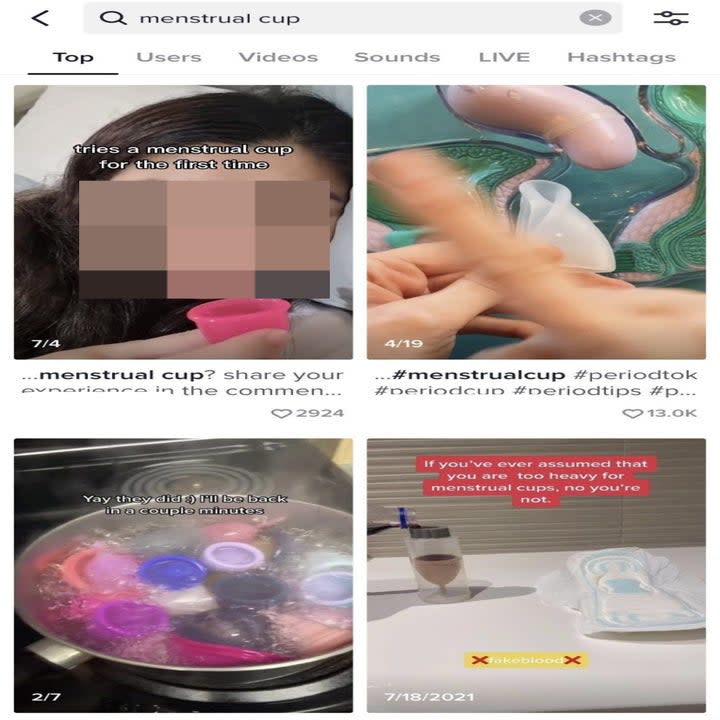
Inspired by watching one too many TikToks of people raving about the benefits of switching to cups — they're cheaper, they're more sustainable, etc. — I decided to try one the next time I had my period. But before I get into my experience, it's important to know what a menstrual cup actually is, in case you're confused like I was. Here are the basics: A menstrual cup is a reusable period device — made out of silicone or rubber — shaped like a funnel that you insert just under your cervix to collect menstrual blood for six to 12 hours.

Before I bought one, I also consulted Dr. Kelli Burroughs, MD, an OB-GYN and Department Chairman of Obstetrics and Gynecology at Memorial Hermann Sugar Land Hospital in Texas, and asked her advice on how to choose the right one.
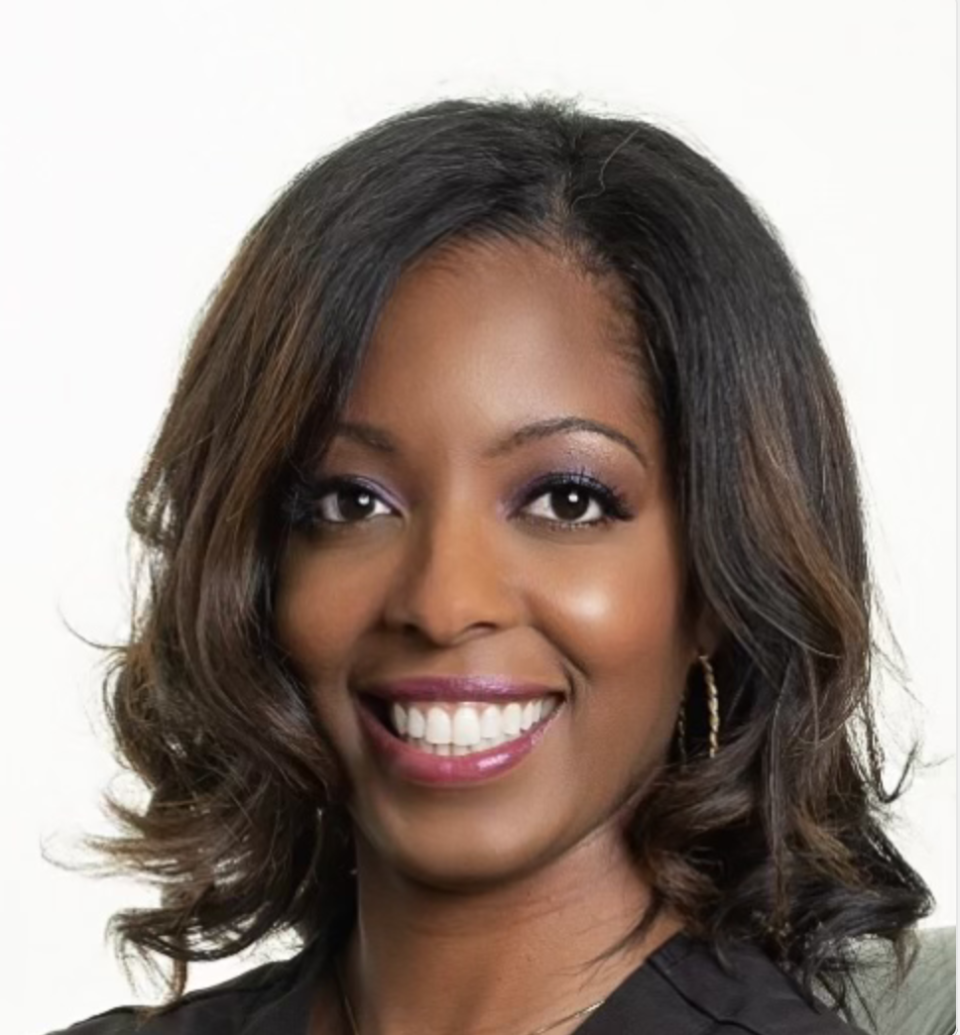
Dr. Burroughs emphasized the importance of trying at least a few in order to find one that fits and wears comfortably. "The menstrual cup game is all about trial and error. There is no reliable way to 'measure the vagina' for a menstrual cup. I recommend patients should be prepared to buy multiple cups until they have identified the right fit," she told BuzzFeed.
Dr. Burroughs' advice made sense, but for budget reasons, I only planned to buy one cup — and when trying to narrow down which one to purchase and try, I was a bit overwhelmed by how many options existed. Still, I did a Google search on the best cups for beginners — and I eventually settled on the Saalt soft menstrual cup ($28.99) due to the many positive reviews it had on Amazon.
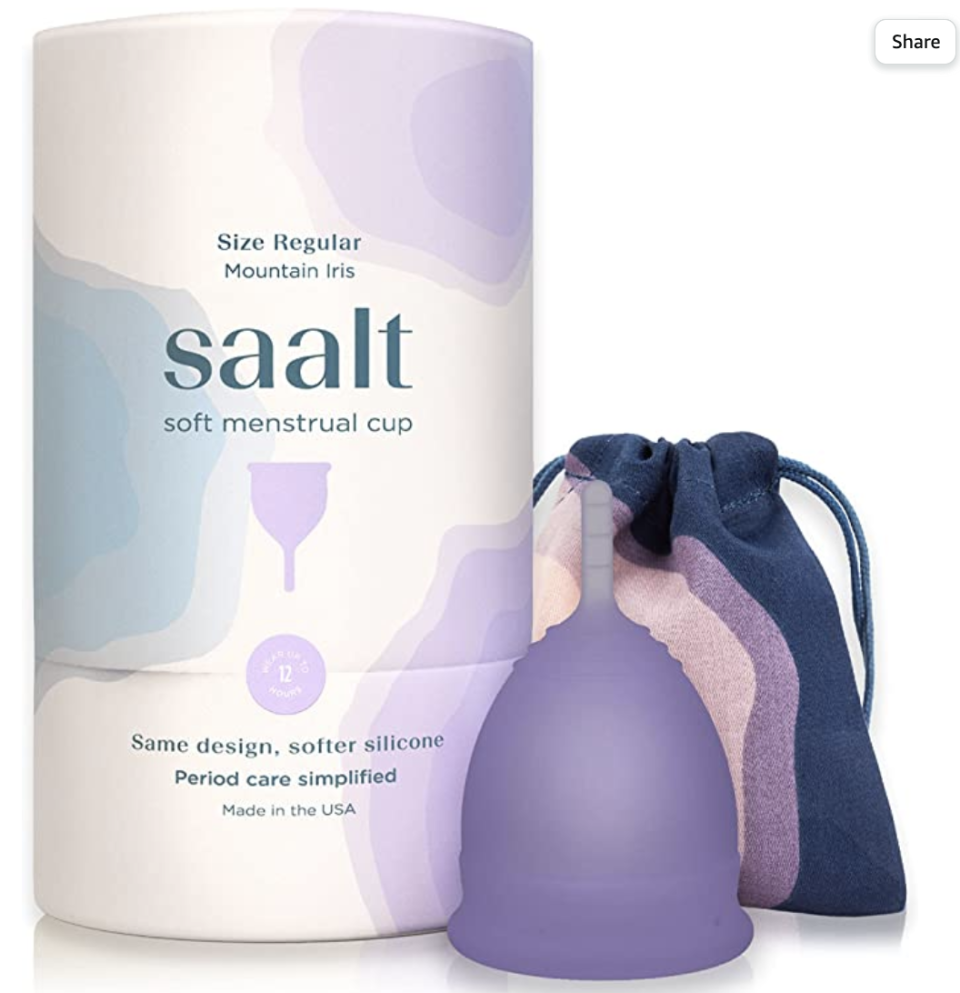
The brand has cups in two different sizes: small for lighter flow and regular for heavy flow. I read on the site that some people use both cup sizes during their cycle as their flow fluctuates. Since I typically have a heavy flow throughout my period, I bought the regular size — which claims to replace four tampons.
Saalt also has a soft and regular version. The soft one was "designed especially for those with a history of bladder sensitivity, cramping or discomfort with firmer cups," according to their site. Since I often get bad period cramps, I went with the soft option.
And the regular one is made from a slightly firmer silicone, which "allows it to open easily when inserted."
After purchasing my cup, I reached out to Dr. Andrea Eisenberg, MD, a board-certified OB-GYN in the metro Detroit area, who spoke about some of the benefits of using a menstrual cup — versus traditional pads or tampons.
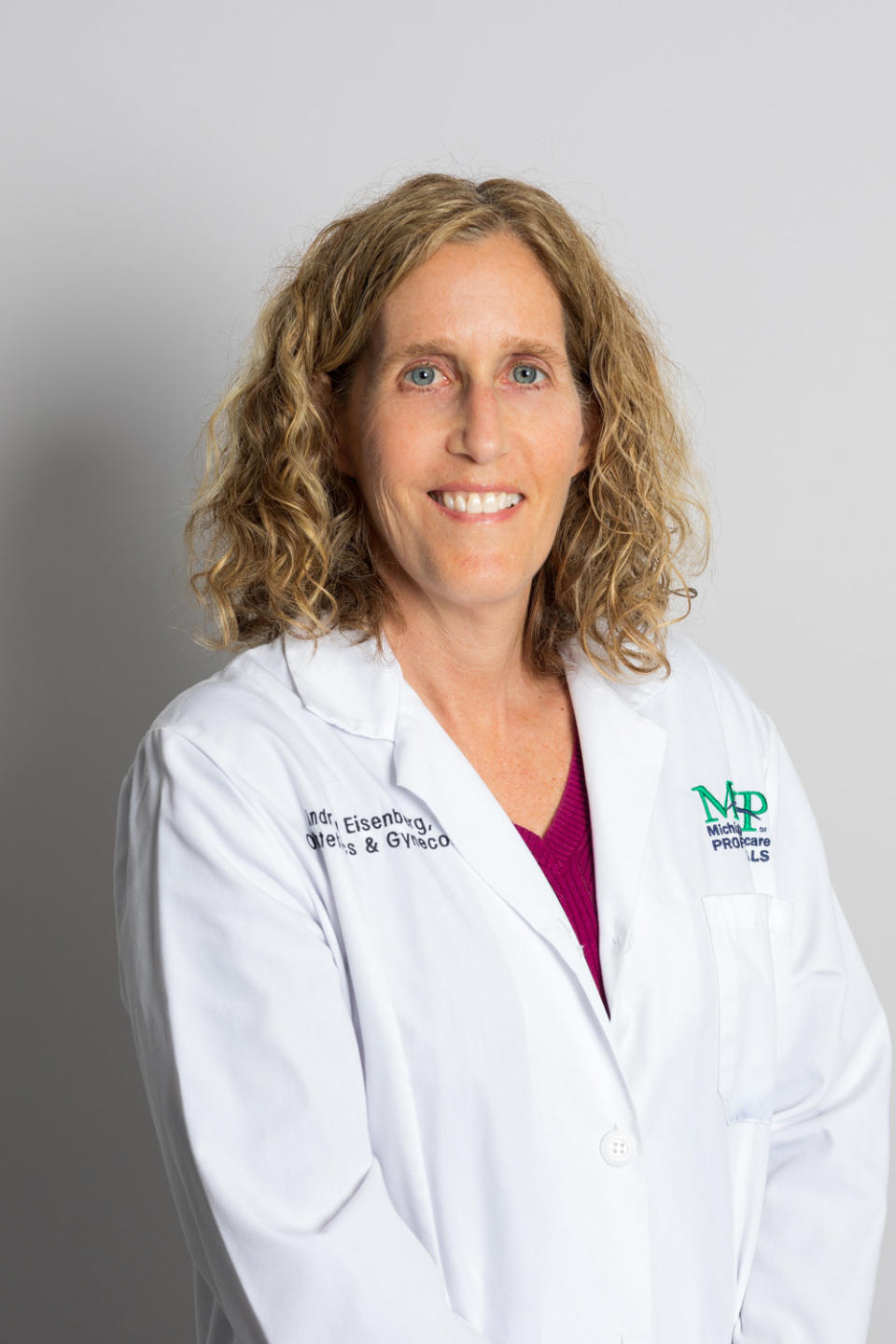
"I think menstrual cups are a great option for women if they are comfortable using them," she told BuzzFeed.
"Not only are they [fairly] simple to insert and remove, but they save women money, the cumbersomeness of carrying and changing tampons and/or pads, and are environmentally friendly," Dr. Eisenberg continued.
For some context on the price difference between cups versus pads or tampons: I spent $28.99 on the Saalt cup — which the company says "can last up to 10 years with proper care." A box of 36 regular tampons usually costs me around $7–$9 depending on the brand and where I purchase them. A package of maxi pads in the size long costs around the same price as the tampons. I usually have to replenish my stock of both products every two to three months.
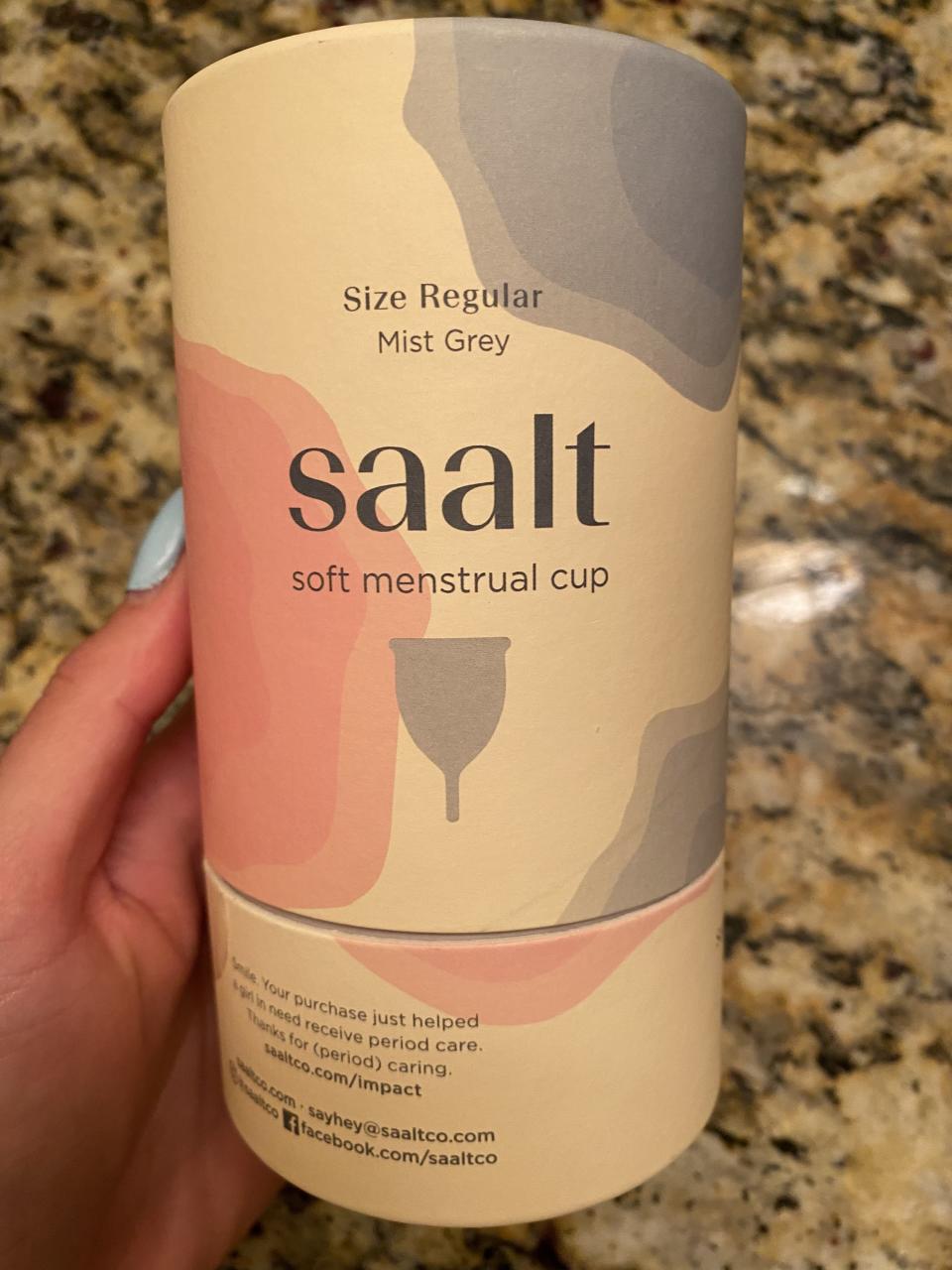
So without further ado, let's get into my experience of trying a menstrual cup for the first time!
The first day of my period was a light flow, so I waited until day two to try out the cup. After opening the package, the cup was smaller and firmer than I expected. For reference on sizing, I compared it to the pads and tampons I typically use in the photo below.
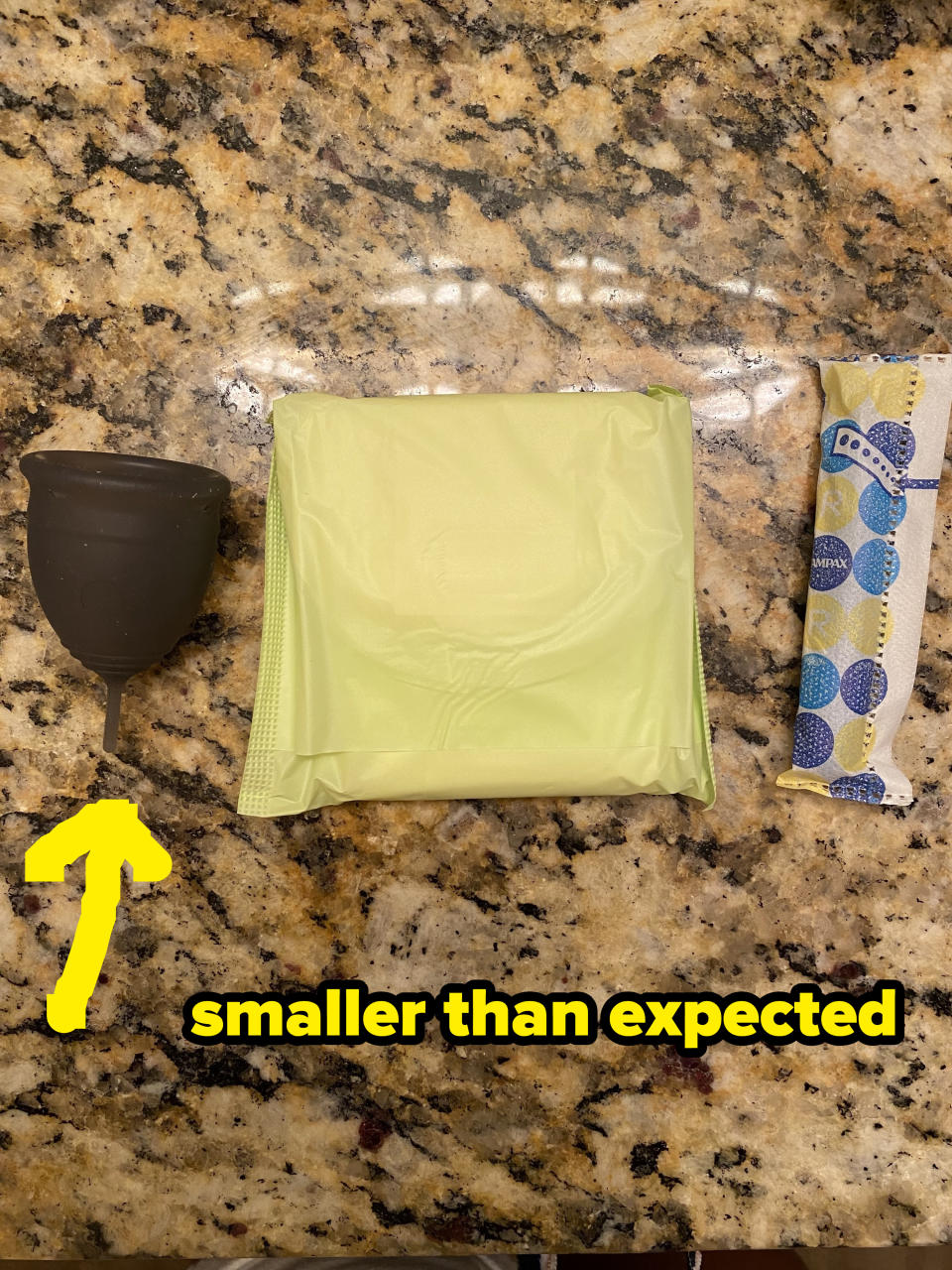
Just a side note: The regular tampons I use are the Pocket Pearls, which open and click into place before inserting it — that's why it looks small in the picture compared to a standard tampon.
In order to sanitize the menstrual cup before first use (and again in between cycles), the instructions tell you to place the cup in boiling water for four to five minutes. After that, I washed my hands, went into my bathroom to squat above my toilet, and took a few deep breaths before attempting to insert the cup.
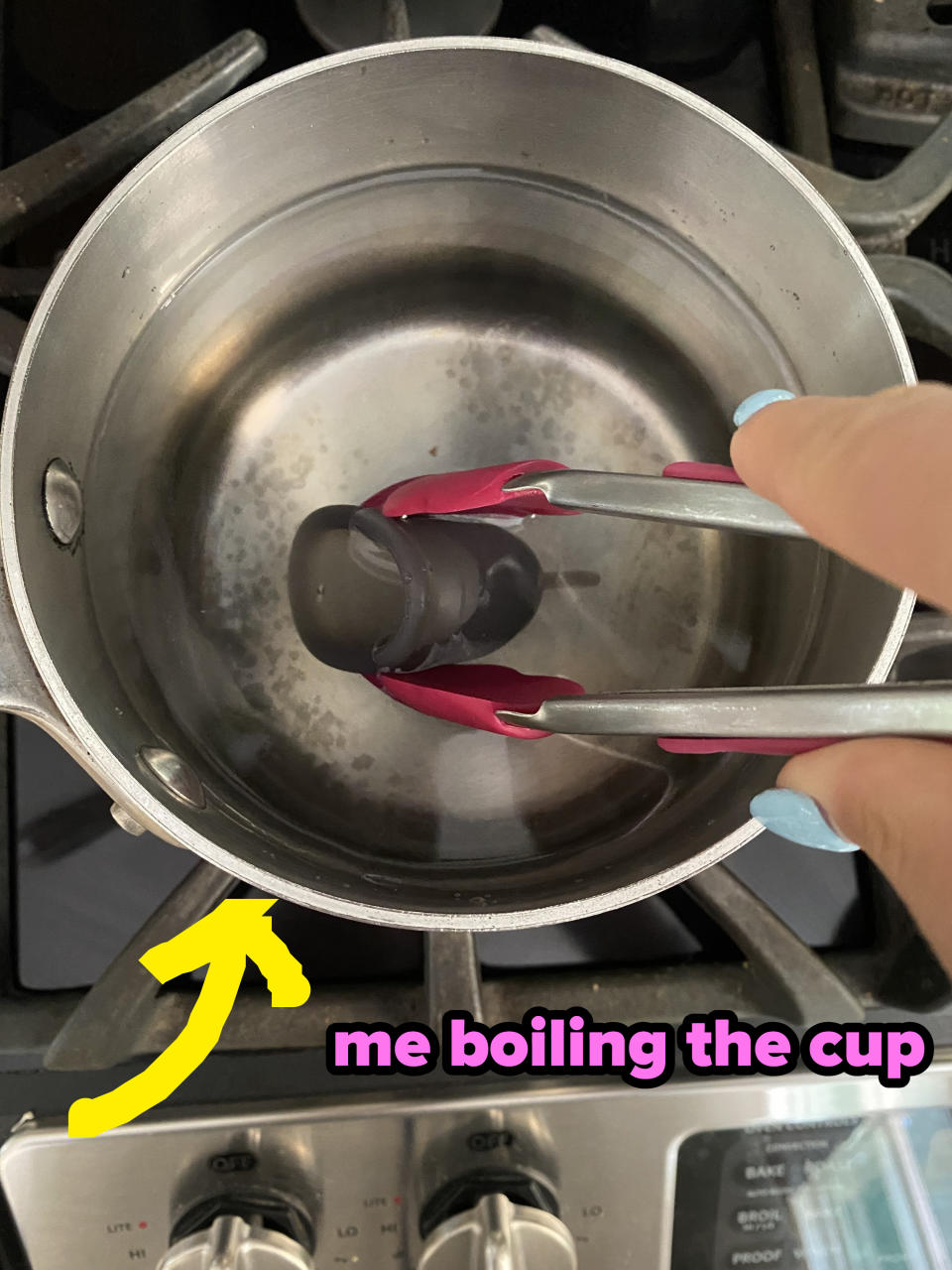
I read the detailed instructions Saalt provided several times because there are different variations of how you could fold and insert the cup.
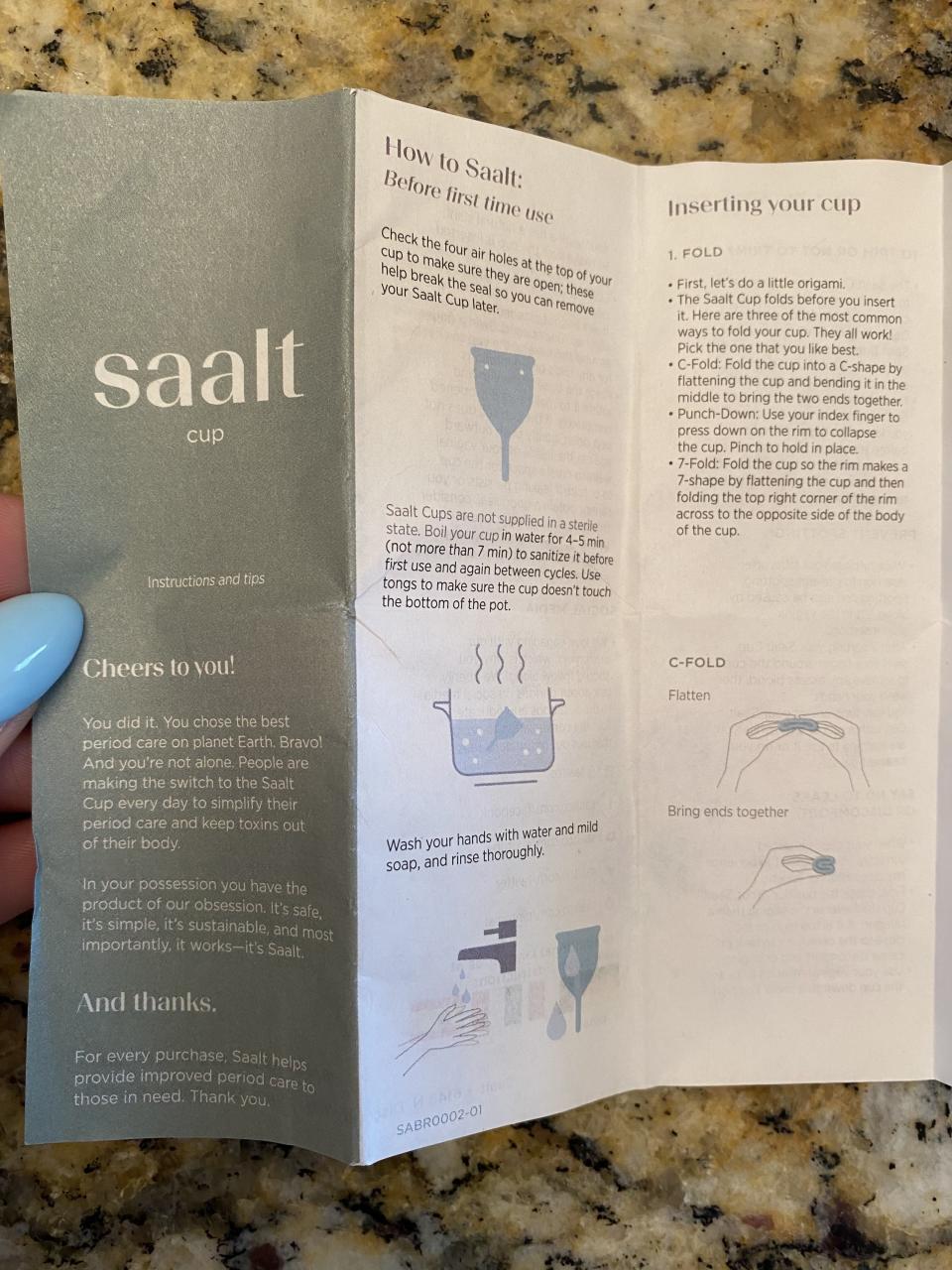
I'm going to be honest with all of you: It took me at least three messy attempts to insert the cup properly without feeling it. I definitely was thinking too much about it. It was the same way I couldn't figure out how to insert a tampon the first time I tried it and I thought I had some sort of blockage down there. 😏
"You should not feel pain or discomfort [when inserting a menstrual cup]. If you do, don’t panic. Gently insert your finger and readjust the cup," explained Dr. Burroughs.
The instructions explained the different ways to insert it, but for me, I found the C-Fold to be the easiest way to insert the cup successfully. This method is folding the cup into a C-shape by flattening the cup and bending it in the middle to bring the two ends together.
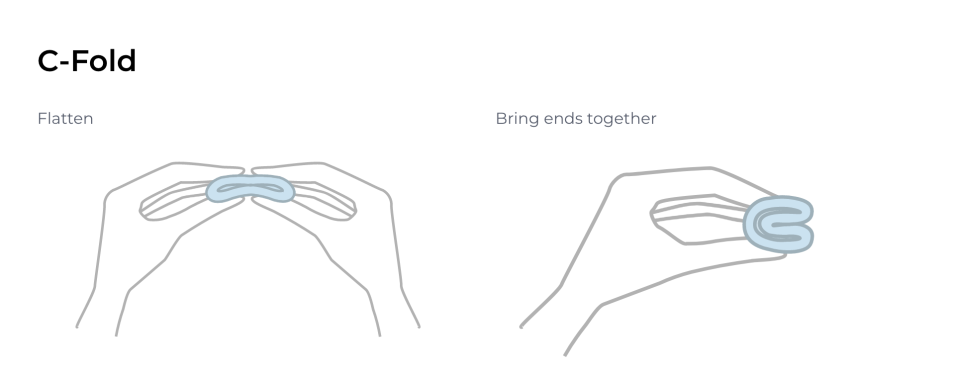
Once it was properly in, I tried not to think too much about it as I went about my day. In fact, I was pretty shocked that I didn't feel anything at all. Even when I went to the bathroom, I didn't feel anything, and I — for lack of a better term — wiped as normal.

Even though a tampon could be used for up to eight hours, the longest I leave one in for is five to six hours. I planned to keep the cup in for as long as I could, obviously not exceeding the recommended 12 hours.
"It is safe to keep the cup in for 12 hours and then remove, clean with warm soapy water, and reinsert," Dr. Eisenberg told BuzzFeed. However, depending on your flow, you might need to empty the cup and reinsert it every four to six hours.
To further put the cup to the test, I purposely exercised at night — after already wearing it for several hours. I still didn't feel like I had anything inserted down there, and at this point I had it in for eight hours. I often get some leakage when using tampons during my period, but I didn't have any with the cup, which was a nice surprise.
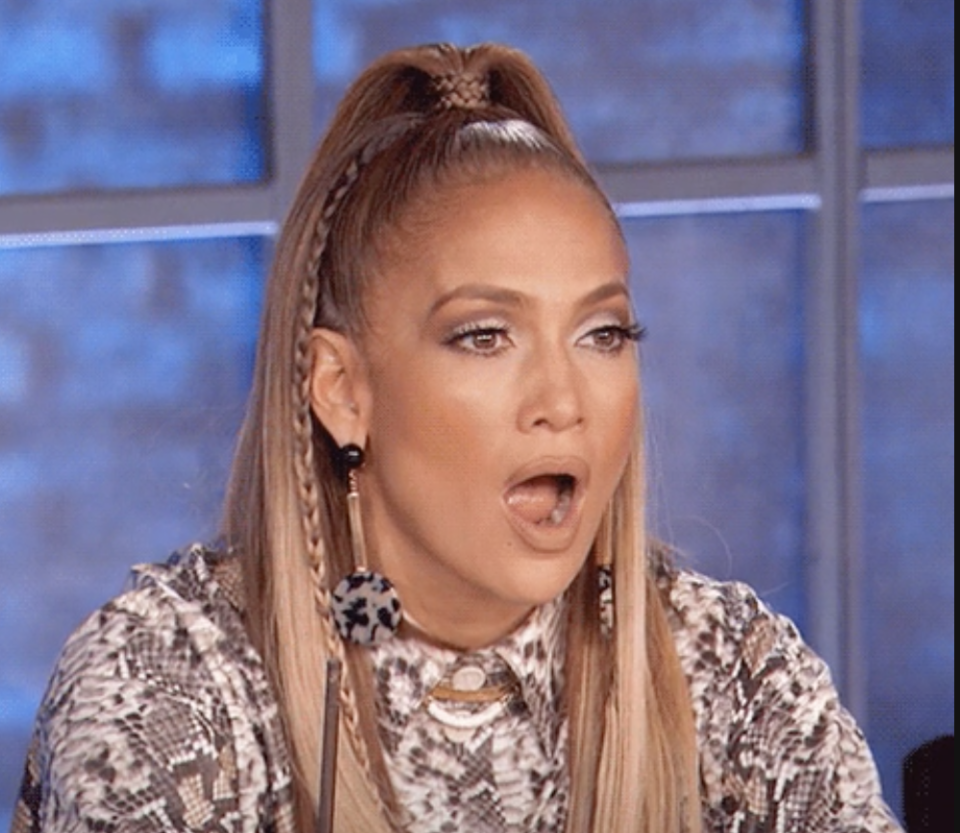
Dr. Burroughs said leakage is possible with menstrual cups, but it's not likely.
"Leakage can occur, but according to limited research, leakage is less likely with a menstrual cup in comparison to a tampon. A menstrual cup can hold up to 1 fluid ounce, which is substantially more than a tampon," she told BuzzFeed.
At the end of the night, before I showered, I washed my hands, nervously stood over my toilet once again, and followed Saalt's instructions to take out the cup.
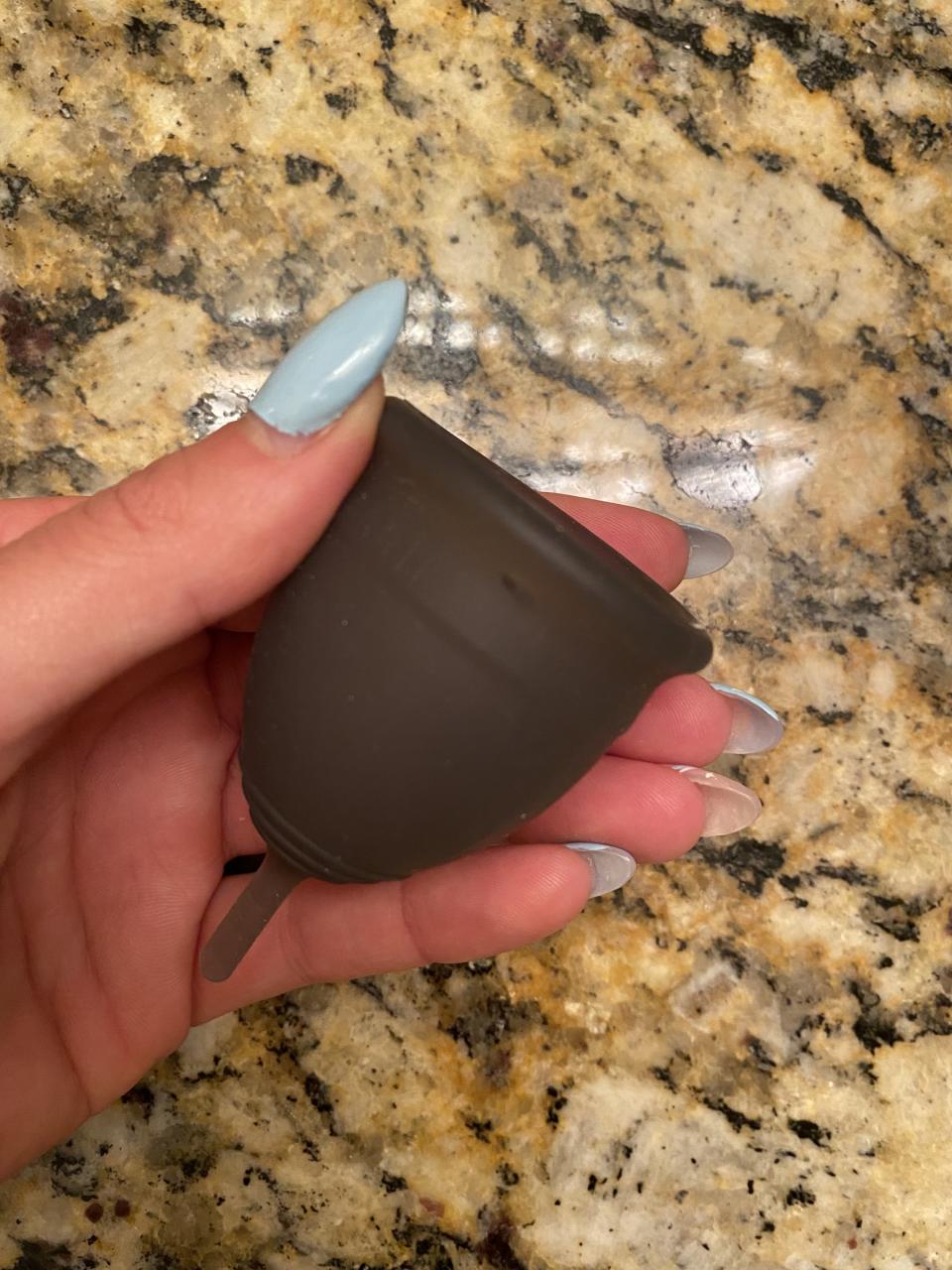
In order to take it out, I had to use my thumb and index finger to reach inside and pinch the base —which breaks the seal — to remove the cup. And to answer the inevitable questions: Yes, it was messy, and yes, I did spill some of the fluids on my toilet bowl seat. I emptied the cup into the toilet, cleaned myself up, and — aside from the slight mess I made as a new user — was surprised at how much I liked the menstrual cup.
I planned on using the cup the next day, so I made sure to wash the cup and set it aside for the night. Even though you can wear a menstrual cup while you're sleeping, I planned on resorting back to good ol' pads. (Just my preference: I don't mind sleeping with pads and don't like the thought of something inside me when I sleep.)
All in all though, I was surprised as to how much I liked the cup — at least for daytime use. At this point, I'm thinking I will use up my existing supply of tampons and then probably replace them entirely with the cup. I do think that using a menstrual cup required a lot of steps compared to just opening a pad or tampon — but I think it's a tradeoff for the money you save and for it being an eco-friendly alternative.
Overall thoughts:
• Price:
After doing the math, the menstrual cup is way more cost-efficient in my case since I typically use both pads and tampons and replenish my stock of them pretty often.
• How comfortable was it?
I'm someone who has a heavy flow but hates wearing a super-size tampon because I can feel it inside me and it's just uncomfortable. I was really surprised at how comfortable the menstrual cup was, and it didn't bother me at all as I went about my day.
• Did I experience any leakage?
Compared to the little leakage I experience with tampons, I personally didn't experience any leakage with the cup.
• Will the cup replace my go-to pads and tampons?
I'll likely replace my daytime tampons with the cup but keep pads for sleeping.
If you're someone who is interested in trying a menstrual cup, there are some important things to keep in mind, according to the doctors I spoke to.
Menstrual cups can be a great option for people who want an alternative to pads or tampons — but they aren't necessarily for everyone. If you experience pain related to vaginismus, endometriosis, or other conditions, discuss with your doctor before trying a menstrual cup.
"Anyone with a phobia of foreign objects in the body should avoid using a menstrual cup," Dr. Burroughs told BuzzFeed. And those who might be sensitive to silicone or rubber material can possibly get an allergic reaction or vaginal irritation.
Overall, if you try a menstrual cup and find it to be uncomfortable or don't like the thought of folding and inserting an object inside your body and never want to try it — that's OK! It's important to listen to your body and do what's best for you.

